TOYOTA AVALON HYBRID 2021 Owners Manual (in English)
Manufacturer: TOYOTA, Model Year: 2021, Model line: AVALON HYBRID, Model: TOYOTA AVALON HYBRID 2021Pages: 560, PDF Size: 13.21 MB
Page 301 of 560
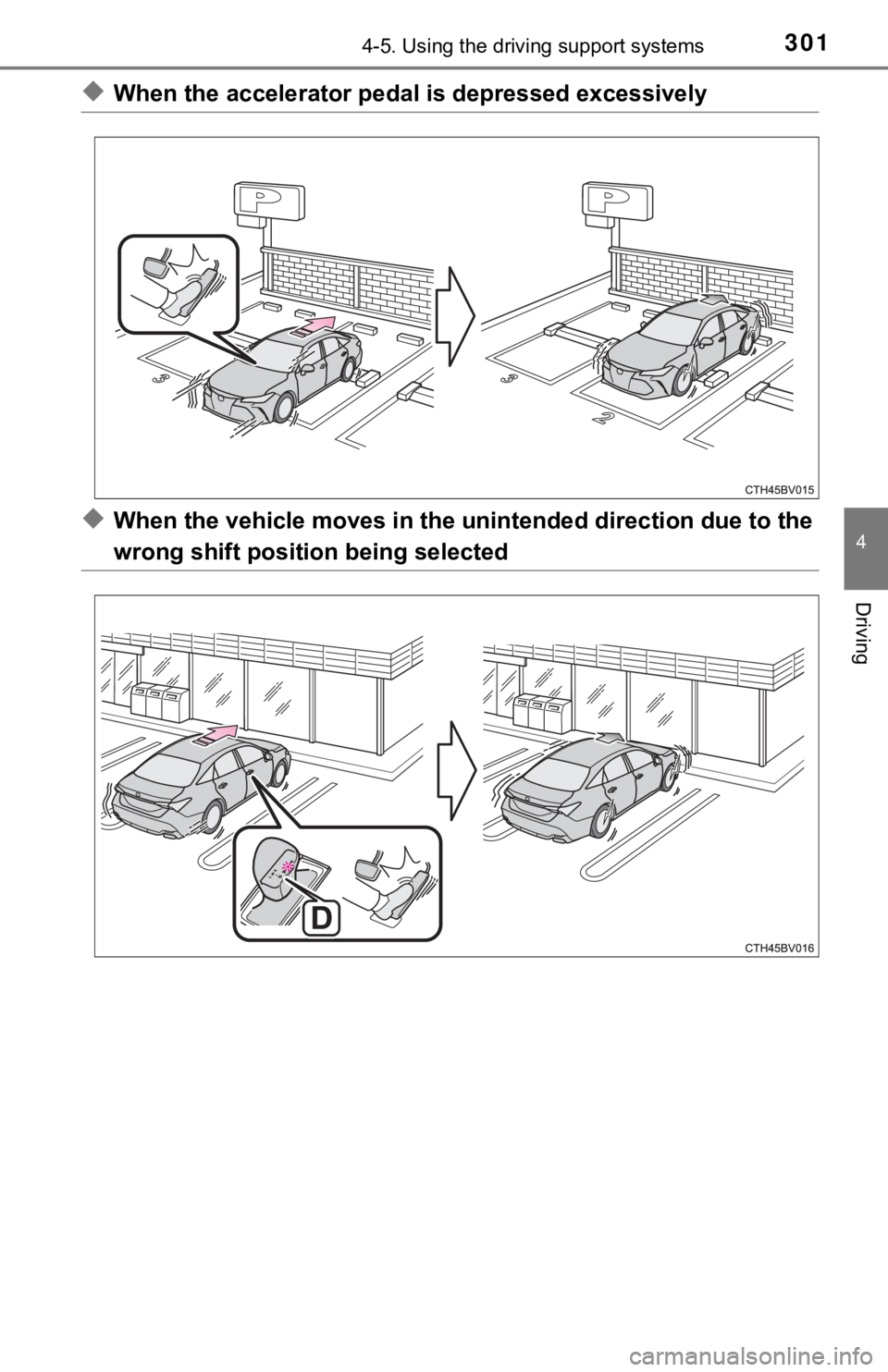
3014-5. Using the driving support systems
4
Driving
◆When the accelerator pedal is depressed excessively
◆When the vehicle moves in the unintended direction due to the
wrong shift position being selected
Page 302 of 560
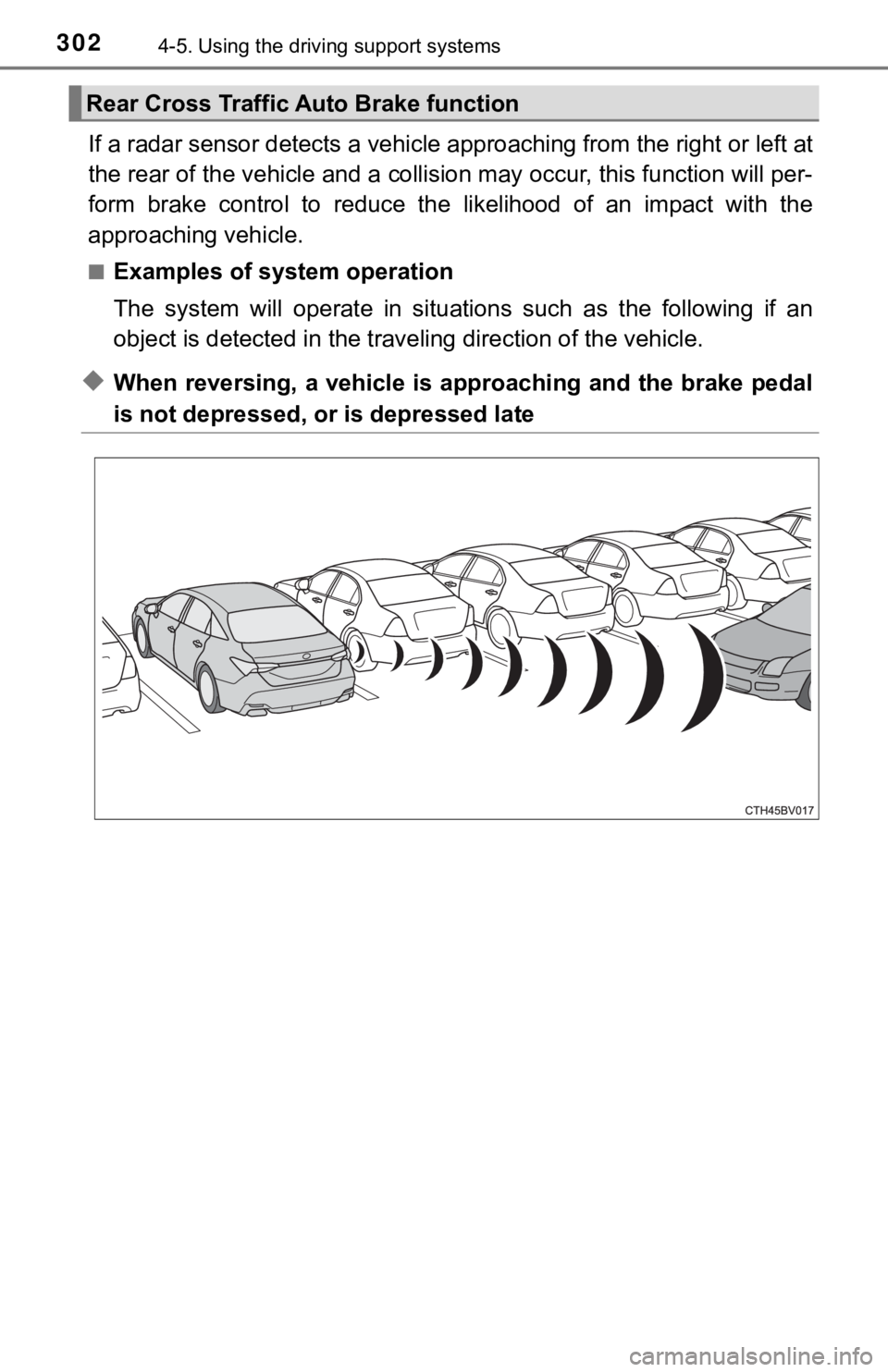
3024-5. Using the driving support systems
If a radar sensor detects a vehicle approaching from the right or left at
the rear of the vehicle and a collision may occur, this function will per-
form brake control to reduce the likelihood of an impact with the
approaching vehicle.
■Examples of system operation
The system will operate in situations such as the following if an
object is detected in the traveling direction of the vehicle.
◆When reversing, a vehicle is approaching and the brake pedal
is not depressed, or is depressed late
Rear Cross Traffic Auto Brake function
Page 303 of 560
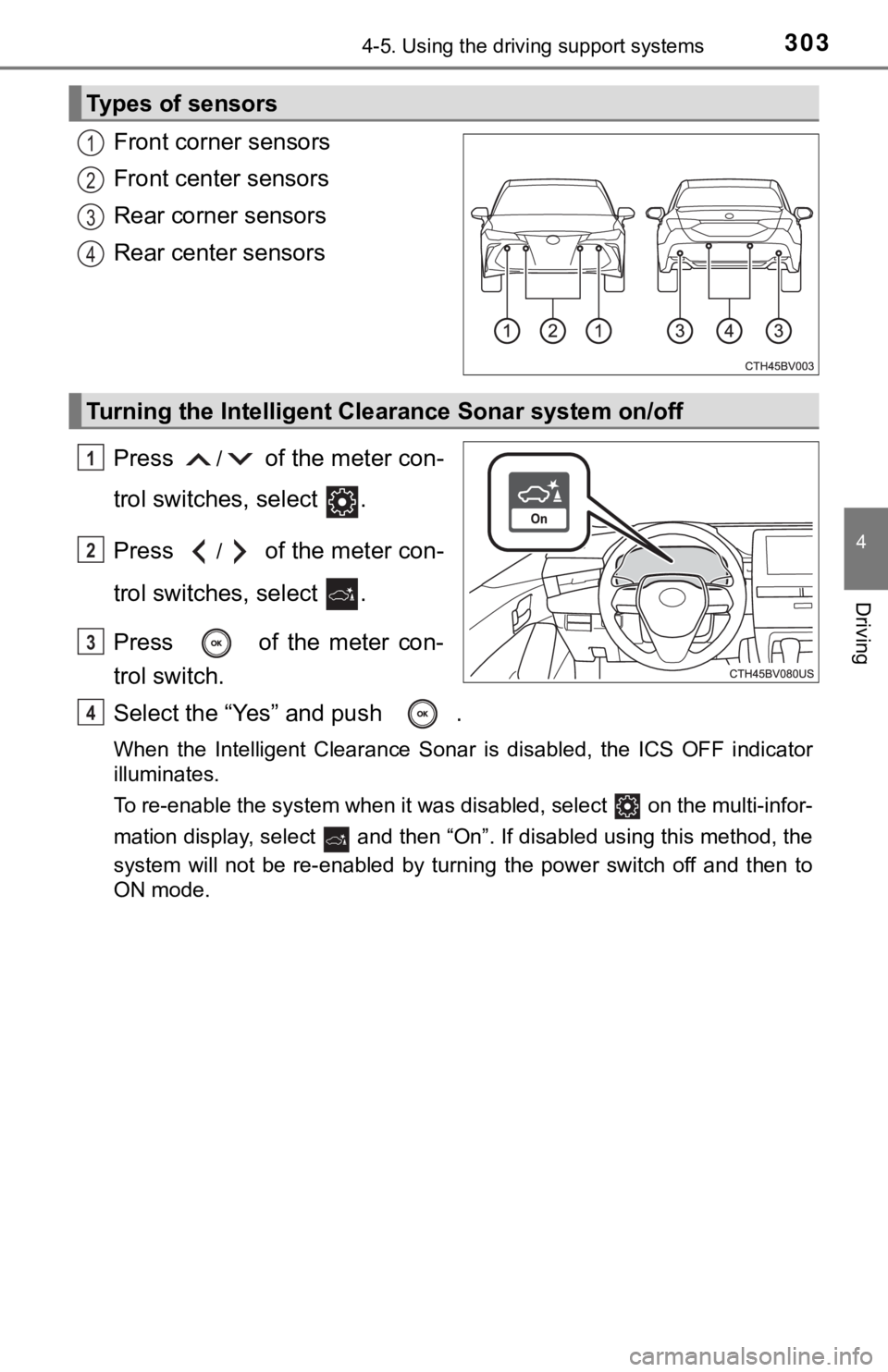
3034-5. Using the driving support systems
4
Driving
Front corner sensors
Front center sensors
Rear corner sensors
Rear center sensors
Press
/ of the meter con-
trol switches, select .
Press
/ of the meter con-
trol switches, select .
Press of the meter con-
trol switch.
Select the “Yes” and push .
When the Intelligent Clearance Sonar is disabled, the ICS OFF indicator
illuminates.
To re-enable the system when it was disabled, select on the multi-infor-
mation display, select and then “On”. If disabled using this method, the
system will not be re-enabled by turning the power switch off and then to
ON mode.
Types of sensors
1
2
3
4
Turning the Intelligent Clearance Sonar system on/off
1
2
3
4
Page 304 of 560
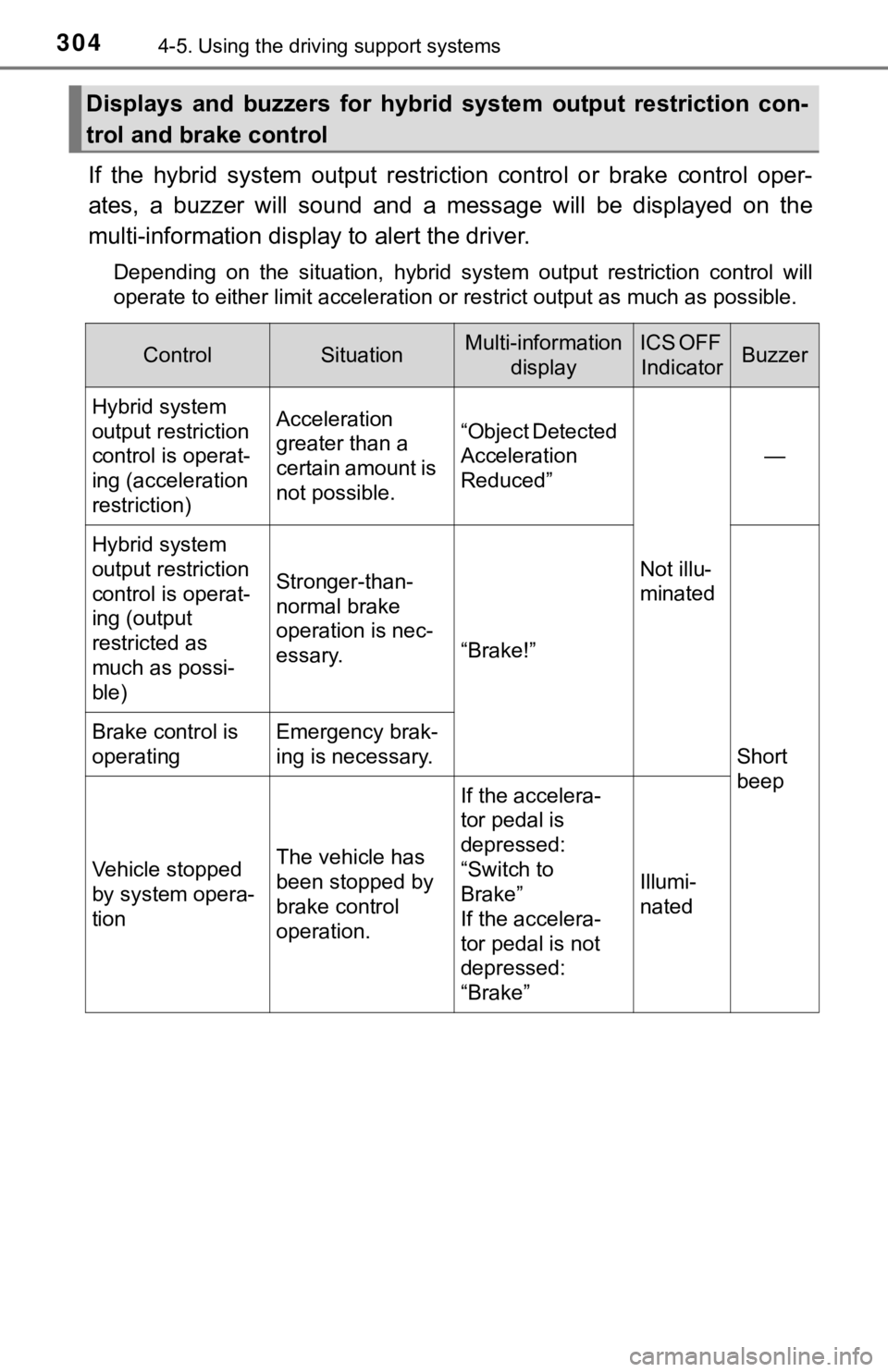
3044-5. Using the driving support systems
If the hybrid system output restriction control or brake control oper-
ates, a buzzer will sound and a message will be displayed on the
multi-information display to alert the driver.
Depending on the situation, hybrid system output restriction control will
operate to either limit acceleration or restrict output as much as possible.
Displays and buzzers for hybrid system output restriction con-
trol and brake control
ControlSituationMulti-information
displayICS OFF
IndicatorBuzzer
Hybrid system
output restriction
control is operat-
ing (acceleration
restriction)Acceleration
greater than a
certain amount is
not possible.“Object Detected
Acceleration
Reduced”
Not illu-
minated
—
Hybrid system
output restriction
control is operat-
ing (output
restricted as
much as possi-
ble)
Stronger-than-
normal brake
operation is nec-
essary.
“Brake!”
Short
beep
Brake control is
operatingEmergency brak-
ing is necessary.
Vehicle stopped
by system opera-
tionThe vehicle has
been stopped by
brake control
operation.
If the accelera-
tor pedal is
depressed:
“Switch to
Brake”
If the accelera-
tor pedal is not
depressed:
“Brake”Illumi-
nated
Page 305 of 560
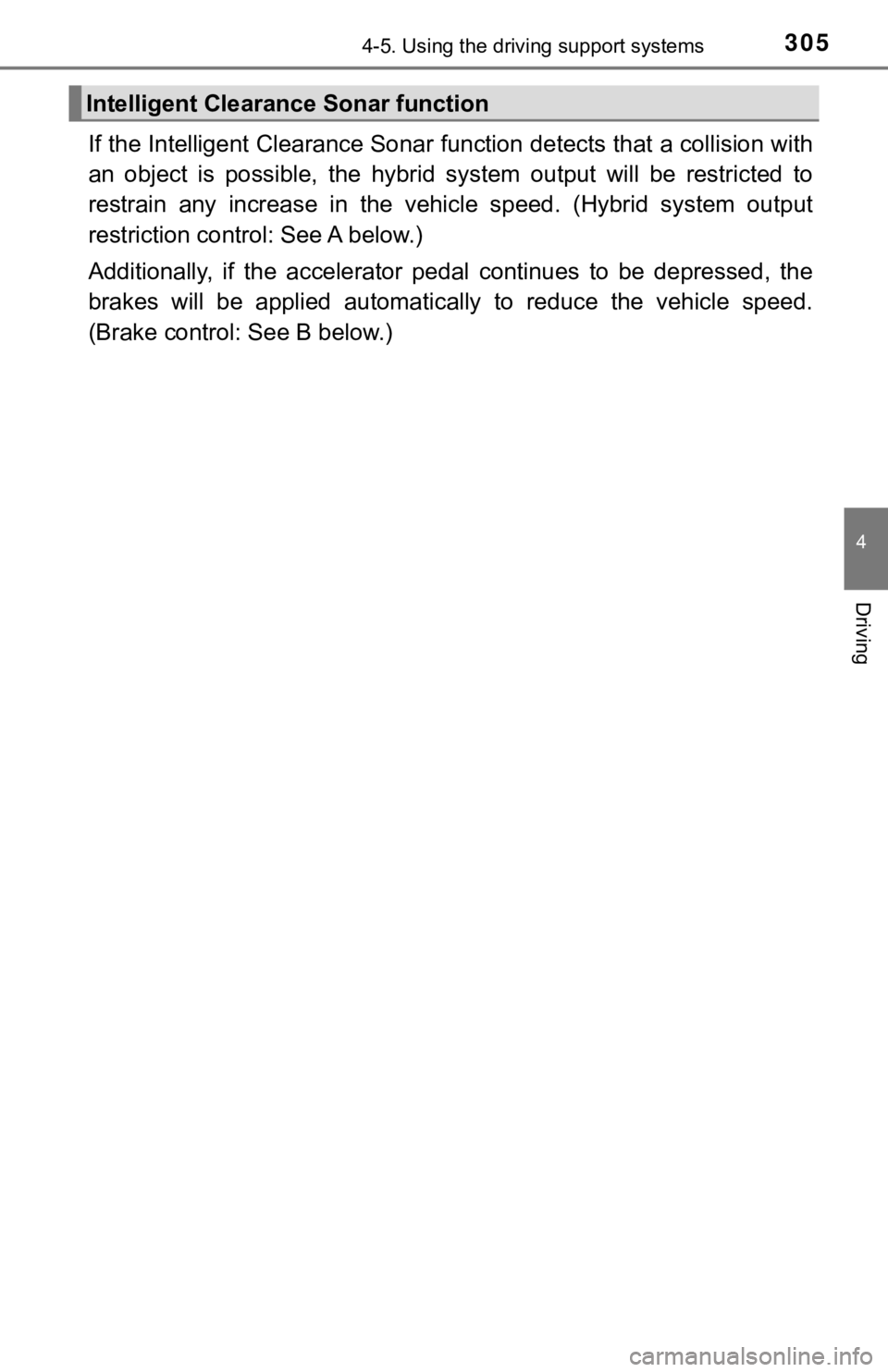
3054-5. Using the driving support systems
4
Driving
If the Intelligent Clearance Sonar function detects that a collision with
an object is possible, the hybrid system output will be restricted to
restrain any increase in the vehicle speed. (Hybrid system output
restriction control: See A below.)
Additionally, if the accelerator pedal continues to be depressed, the
brakes will be applied automatically to reduce the vehicle speed.
(Brake control: See B below.)
Intelligent Clearance Sonar function
Page 306 of 560
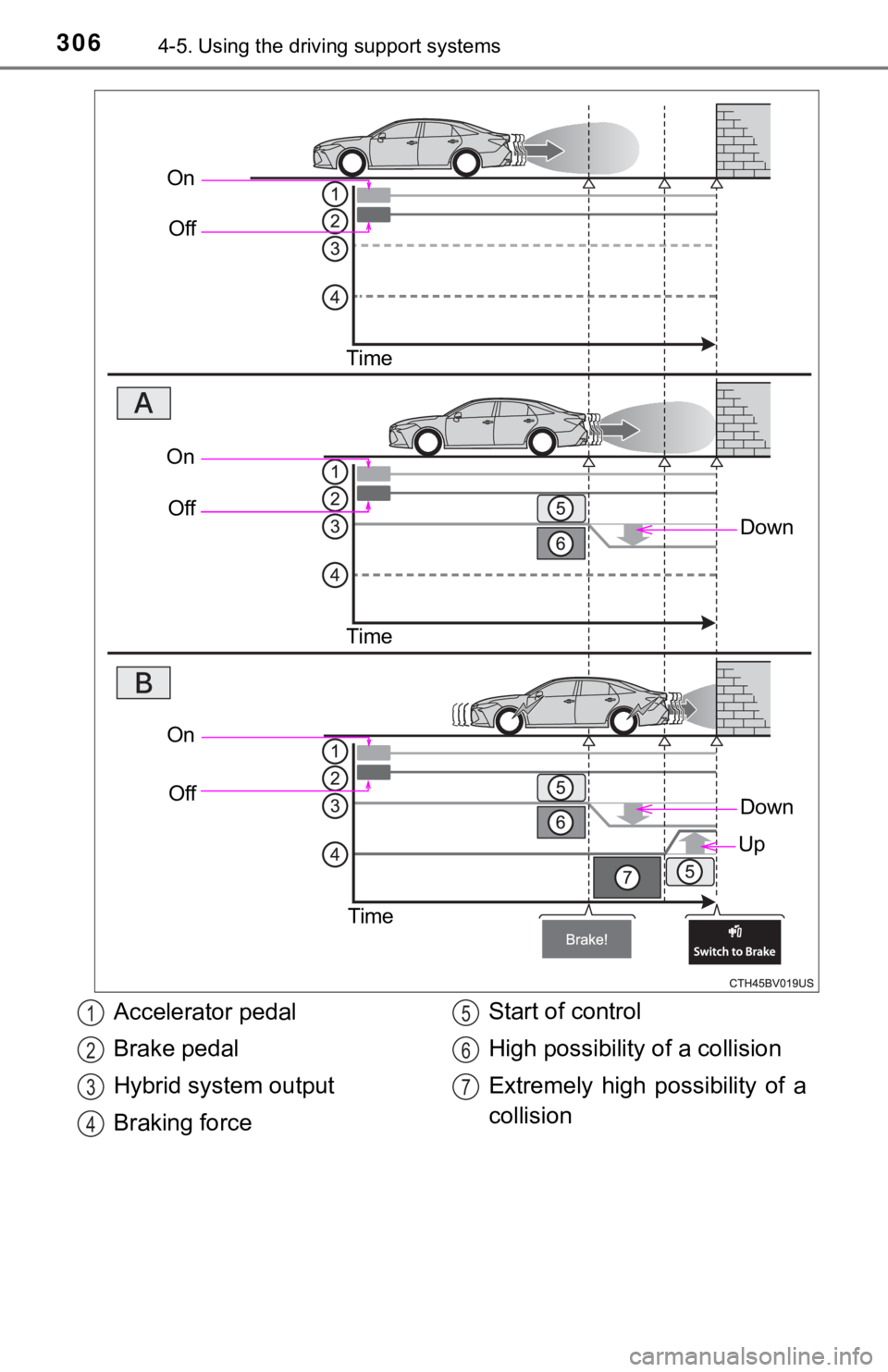
3064-5. Using the driving support systems
On
Off
Time
Down
On
Off
Time
On
Off
Time
Down
Up
Accelerator pedal
Brake pedal
Hybrid system output
Braking forceStart of control
High possibility of a collision
Extremely high possibility of a
collision1
2
3
4
5
6
7
Page 307 of 560

3074-5. Using the driving support systems
4
Driving
■The Intelligent Clearance Sonar function will operate when
The function will operate when the ICS OFF indicator is not illuminated or
flashing (P. 303, 311) and all of the following conditions are met:
●Hybrid system output restriction control
• The Intelligent Clearance Sonar system is enabled.
• The vehicle speed is 10 mph (15 km/h) or less.
• There is an object in the traveling direction of the vehicle and 6 to 13 ft. (2
to 4 m) away.
• The system determines that a stronger-than-normal brake operation is
necessary to avoid a collision.
●Brake control
• Hybrid system output restriction control is operating.
• The system determines that an emergency brake operation is necessary
to avoid a collision.
■The Intelligent Clearance Sonar function will stop operating when
The function will stop operating if any of the following conditions are met:
●Hybrid system output restriction control
• The Intelligent Clearance Sonar system is disabled.
• The collision becomes avoidable with normal brake operation.
• The object is no longer 6 to 13 ft. (2 to 4 m) away in the traveling direction
of the vehicle.
●Brake control
• The Intelligent Clearance Sonar system is disabled.
• Approximately 2 seconds elapse after the vehicle is stopped by brake
control.
• The brake pedal is depressed after the vehicle is stopped by brake con-
trol.
• The object is no longer 6 to 13 ft. (2 to 4 m) away in the traveling direction
of the vehicle.
■Detection range of the Intelligent Clearance Sonar function
The detection range of the Intelligent Clearance Sonar function differs from
the detection range of the intuitive parking assist. (P. 295)
Therefore, even if the intuitive parking assist detects an object and provides a
<005a004400550051004c0051004a000f00030057004b00480003002c005100570048004f004f004c004a00480051005700030026004f0048004400550044005100460048000300360052005100440055000300490058005100460057004c00520051000300
500044005c0003005100520057000300560057004400550057[ operating.
■If the Intelligent Clearance Sonar function has operated
If the vehicle is stopped due to operation of the Intelligent Clearance Sonar
function, the Intelligent Clearance Sonar system will be disabled and the ICS
OFF indicator will illuminate.
Page 308 of 560

3084-5. Using the driving support systems
■Re-enabling the Intelligent Clearance Sonar system
To re-enable the Intelligent Clearance Sonar system when it is disabled due
to operation of the Intelligent Clearance Sonar function, either enable the sys-
tem again (P. 303), or turn the power switch off and then back to ON mode.
Additionally, if the object becomes no longer in the traveling direction of the
vehicle or if the traveling direction of the vehicle changes (such as changing
from moving forward to backing up, or from backing up to moving forward),
the system will be re-enabled automatically.
■Objects that the Intelligent Clearance Sonar function may not detect
The sensors may not be able to detect certain objects, such as the following.
●Cotton cloth, snow, and other materials that are poor reflectors of ultrasonic
waves.
(People may also not be detected depending on the type of clothing they are
wearing.)
●Objects which are not perpendicular to the ground, are not perpendicular to
<0057004b0048000300570055004400590048004f004c0051004a00030047004c0055004800460057004c0052005100030052004900030057004b0048000300590048004b004c0046004f0048000f0003004400550048000300580051004800590048005100
030052005500030044005500480003005a00440059004c0051[g.
●Low objects
●Thin objects such as wires, fences, ropes and signposts
●Objects that are extremely close to the bumper
■Situations in which the Intelligent Clearance Sonar may not operate
properly
When the shift lever is in N.
■Intuitive parking assist buzzer
Regardless of whether the intuitive parking assist system is enabled or not
(P. 292), if the Intelligent Clearance Sonar system is enabled (P. 303),
the front or rear sensors detect an object and brake control is performed, the
intuitive parking assist buzzer will sound to notify the driver of the approxi-
mate distance to the object.
Page 309 of 560
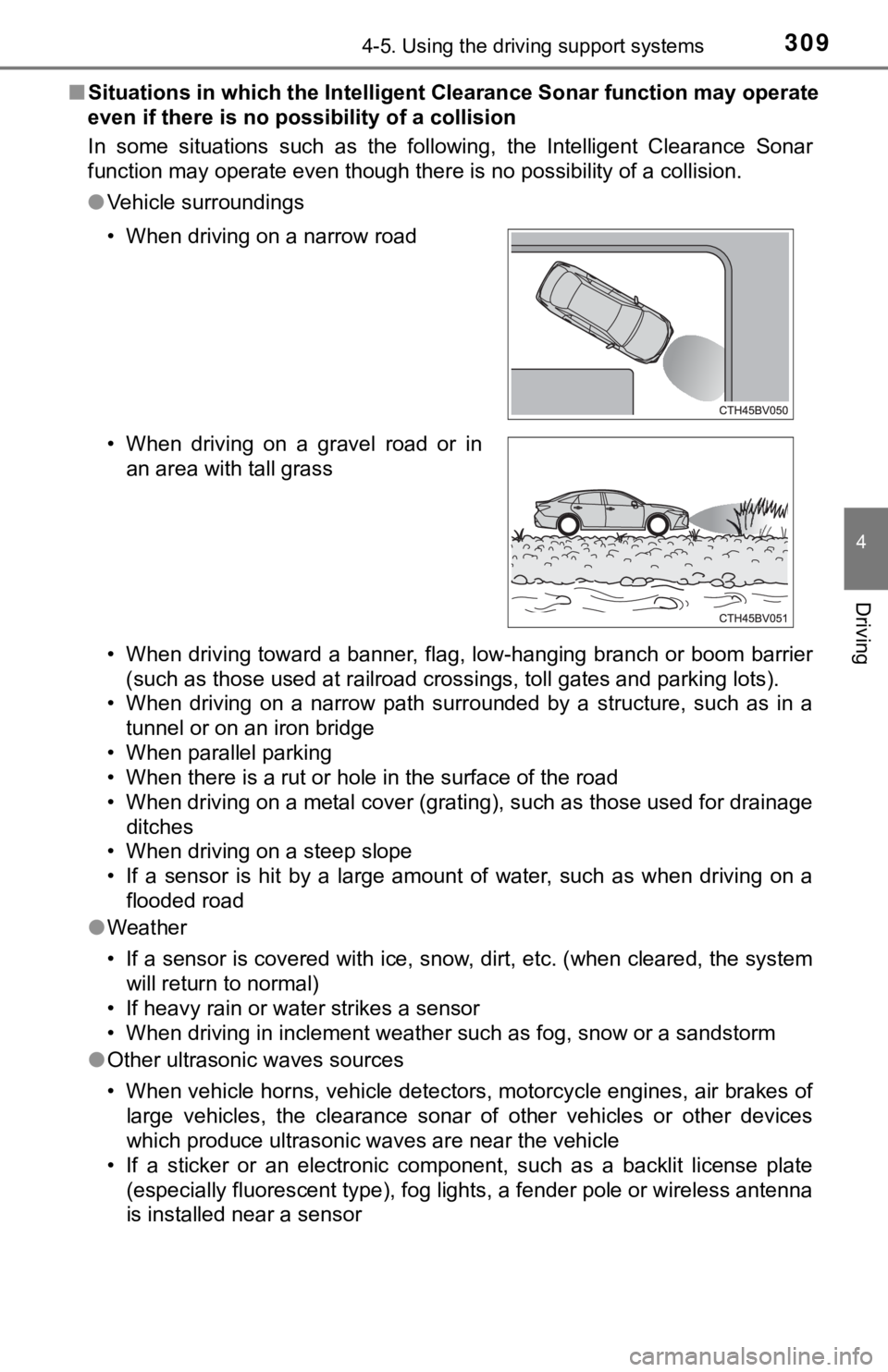
3094-5. Using the driving support systems
4
Driving
■Situations in which the Intelligent Clearance Sonar function may operate
even if there is no possibility of a collision
In some situations such as the following, the Intelligent Clearance Sonar
function may operate even though there is no possibility of a collision.
●Vehicle surroundings
• When driving toward a banner, flag, low-hanging branch or boom barrier
(such as those used at railroad crossings, toll gates and parking lots).
• When driving on a narrow path surrounded by a structure, such as in a
tunnel or on an iron bridge
• When parallel parking
• When there is a rut or hole in the surface of the road
• When driving on a metal cover (grating), such as those used for drainage
ditches
• When driving on a steep slope
• If a sensor is hit by a large amount of water, such as when driving on a
flooded road
●Weather
• If a sensor is covered with ice, snow, dirt, etc. (when cleared, the system
will return to normal)
• If heavy rain or water strikes a sensor
• When driving in inclement weather such as fog, snow or a sandstorm
●Other ultrasonic waves sources
• When vehicle horns, vehicle detectors, motorcycle engines, air brakes of
large vehicles, the clearance sonar of other vehicles or other devices
which produce ultrasonic waves are near the vehicle
• If a sticker or an electronic component, such as a backlit license plate
(especially fluorescent type), fog lights, a fender pole or wireless antenna
is installed near a sensor • When driving on a narrow road
• When driving on a gravel road or in
an area with tall grass
Page 310 of 560
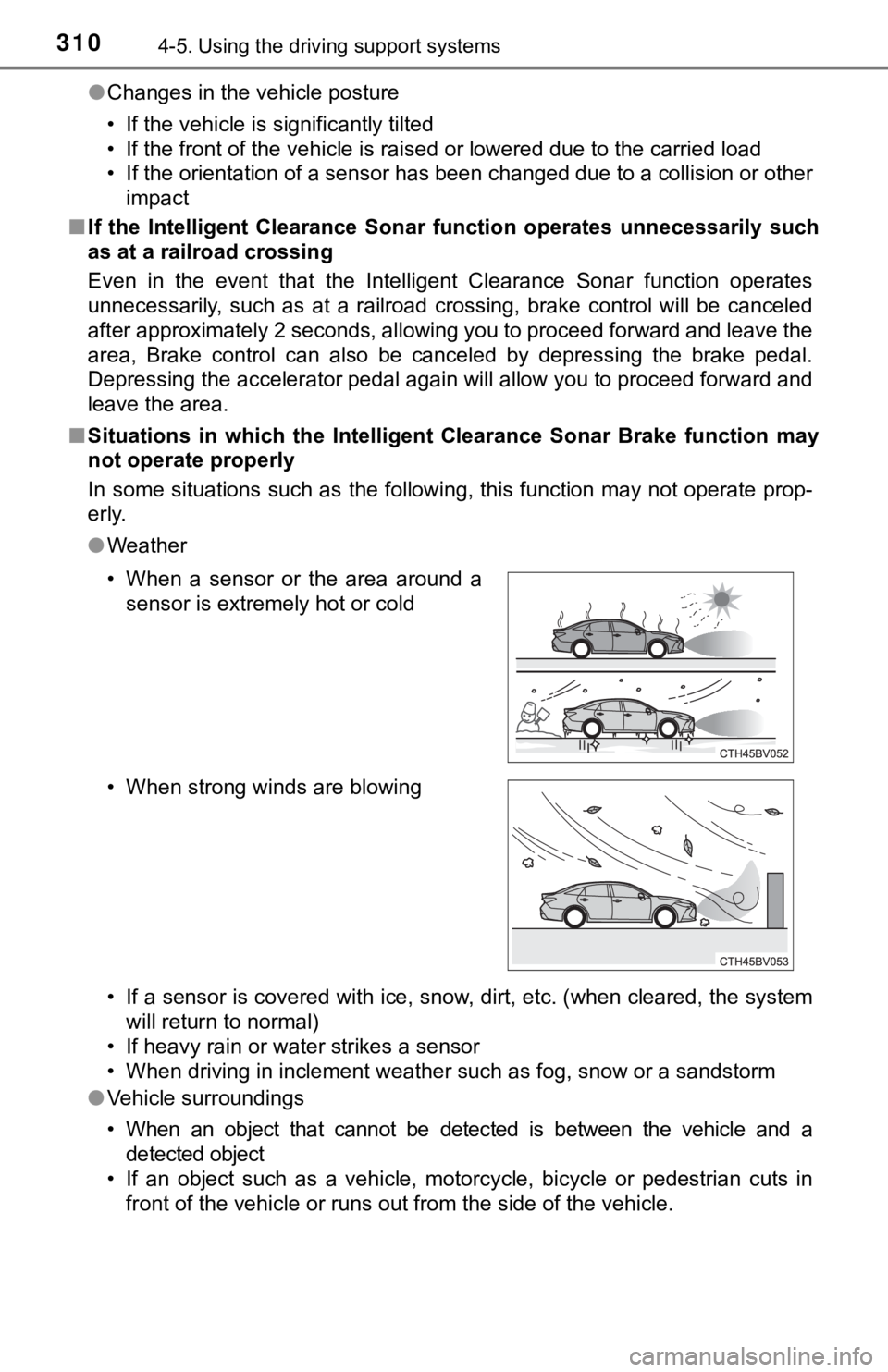
3104-5. Using the driving support systems
●Changes in the vehicle posture
• If the vehicle is significantly tilted
• If the front of the vehicle is raised or lowered due to the carried load
• If the orientation of a sensor has been changed due to a collision or other
impact
■If the Intelligent Clearance Sonar function operates unnecessarily such
as at a railroad crossing
Even in the event that the Intelligent Clearance Sonar function operates
unnecessarily, such as at a railroad crossing, brake control will be canceled
after approximately 2 seconds, allowing you to proceed forward and leave the
area, Brake control can also be canceled by depressing the brake pedal.
Depressing the accelerator pedal again will allow you to proceed forward and
leave the area.
■Situations in which the Intelligent Clearance Sonar Brake function may
not operate properly
In some situations such as the following, this function may not operate prop-
erly.
●Weather
• If a sensor is covered with ice, snow, dirt, etc. (when cleared, the system
will return to normal)
• If heavy rain or water strikes a sensor
• When driving in inclement weather such as fog, snow or a sandstorm
●Vehicle surroundings
• When an object that cannot be detected is between the vehicle and a
detected object
• If an object such as a vehicle, motorcycle, bicycle or pedestrian cuts in
front of the vehicle or runs out from the side of the vehicle. • When a sensor or the area around a
sensor is extremely hot or cold
• When strong winds are blowing